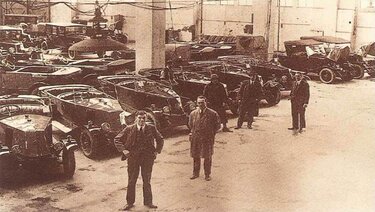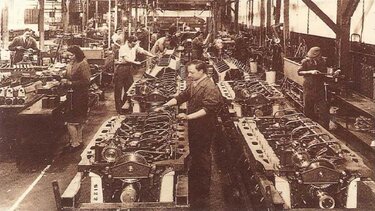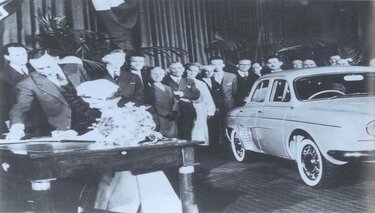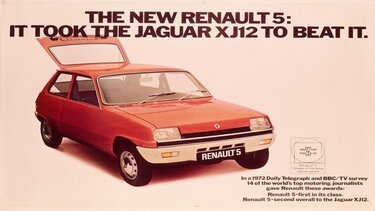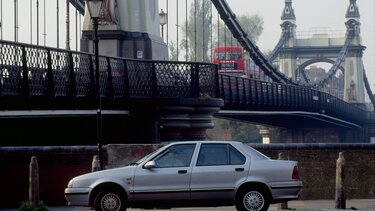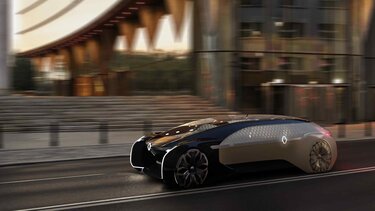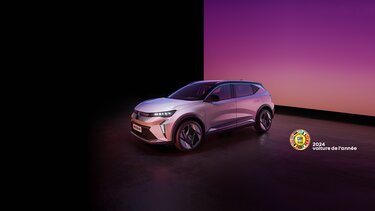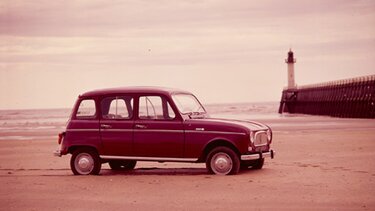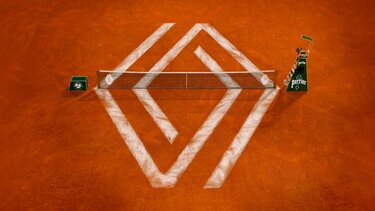The most British of French car manufacturers
1902-1911
A proud heritage
1902: Renault arrives in England for the first time, with 30 cars imported by Roadway Autocar Company on Edgware Road. Quickly enough, sales soared to 250 cars, 2 years later 450 by 1904, by that time the roadway autocar co had become Renault freres and in the following year Renault became one of the earliest members of the society of motor manufacturers and traders.
1905: First Renault sale to the British Royal Family. King Edward VII buys a 14/20 hp Landaulette.
1911: Now firmly established in the UK and even royally appointed under its new title of Renault Ltd, the company establishes a prestige showroom in London’s Pall Mall, just off St. James’s Square.
1914-1954
Renault in War time
1914: Renault’s sales are now running at 1,700 vehicles a year, but with the outbreak of World War I, the company concentrates on the production of aircraft engine components and aero engines for the War Office.
1926: Renault establishes its UK base in Acton — despite concerns about its remoteness from the capital!
1939: The Second World War sees Renault Ltd again supplying aircraft and marine engines to the Allied war effort once again.
1945: Because of post-war economic restrictions, Renault Ltd has to export as much as 85% of its production, leaving only about 200 cars a year to be divided among 50 agents.
1950-1961
Deep roots, strong growth
1950: Renault becomes more than an importer of French cars; it is now assembling the famous 4CV and Dauphine in the Acton factory.
1957: Queen Elizabeth II accepts the gift of a Renault Dauphine built at Acton.
1959: With import quotas being abolished finally, Renault’s real era of expansion in the UK begins. Stepped up demand for the Dauphine now leads to imports of French-built Dauphines to supplement Acton production which is now running at 2,000 a year.
1960: With the British car boom in full swing, Renault opens an import centre at Southampton, fed by ferries operating direct out of Le Havre.
1961: The introduction of the new Renault 4 and the level of demand, by now far in excess of the Acton assembly line’s capacity, led to the decision to import all vehicles from France. As it transpired, this decision was to play a powerful part in the evolution of the company, and ultimately in the creation of Renault UK as we know it today.
1970-1983
Modern era
1970: On the eve of the 1973 energy crisis and throughout most of this decade, Renault’s compact and economical cars such as Renault 4, R5, R6 and R12… perform well, maintaining Renault’s sales in the country.
1975: Substantially greater investment in the Renault parts facility became essential by the middle of the 1970s, with Renault ownership in the UK exceeding 750,000 vehicles. A £2.3 million National Parts Centre at Reading soon reached its workable limits.
1983: In the early 1980s, Renault UK experienced financial issues; a result of the over-staffing and too wide a spread of interests and financial resources. However Renault successfully handled it: Operations peripheral to the mainstream activity — the making of vehicles — were closed down or sold off and a vigorous programme of rationalisation was introduced.
1984-2006
Through success and crisis
1984: Renault launched the first multi-purpose vehicle - Espace, more than 10 years before its competitors, defining a whole new car segment.
1990: Although successful on the road and on track, Renault experiences financial troubles and only Collaboration with Volvo and the privatisation of Renault (becoming Renault SA) allowed the company to get back on its feet.
1991: Renault experienced a resurgence in popularity in the UK in 1991 with the launch of Renault Clio and its unforgettable advertising campaign: “Papa, Nicole” (a running series that lasted for seven years, ending with the most-watched TV commercial of all time with over 23 million viewers tuning in).
1996: The successor of R19, Renault Mégane, is one of the first cars to achieve a 4 star rating, the highest at the time, in the EuroNCAP crash test in passenger safety.
2006: Audacious launches followed in the noughties (such as the distinctively styled, Renault Mégane hatchback and its provocative boot form), leading Renault to become in 2006 the UK’s third biggest car brand.
2010 - 2021
Renault’s resurgence
After experiencing a rough patch at the end of the 2000’s, Renault is back on track:
Presenting a refreshed range of vehicles such as the All-New CLIO, Captur crossover and New ZOE;
Launching the first Electric Vehicles range in the country in the UK;
Bringing Dacia to the UK shores in 2011, a brand that has been a massive hit with the public.
The brand is now focusing on what it does best: delivering innovative vehicles with a touch of French flair.
today and the future
a new organisation
2023 - Renault Group launched its Revolution by concentrating its resources on the value chains emerging from the transformation of the automotive and mobility industry: electric vehicles (EV), software, new mobility services, circular economy, in addition to thermal and hybrid vehicles. In 2023, Renault Group carved out two new entities, Horse and Ampere.
2024 - Reveal of Renault Scenic E-Tech electric. Unveiled at the IAA Mobility show in Munich in September 2023, Scenic E-Tech electric completes Renault's range of electric vehicles in the C-segment. It was awarded the "Car of the Year 2024" title by the European COTY jury.
Get to know us better
Discover more about our brand

